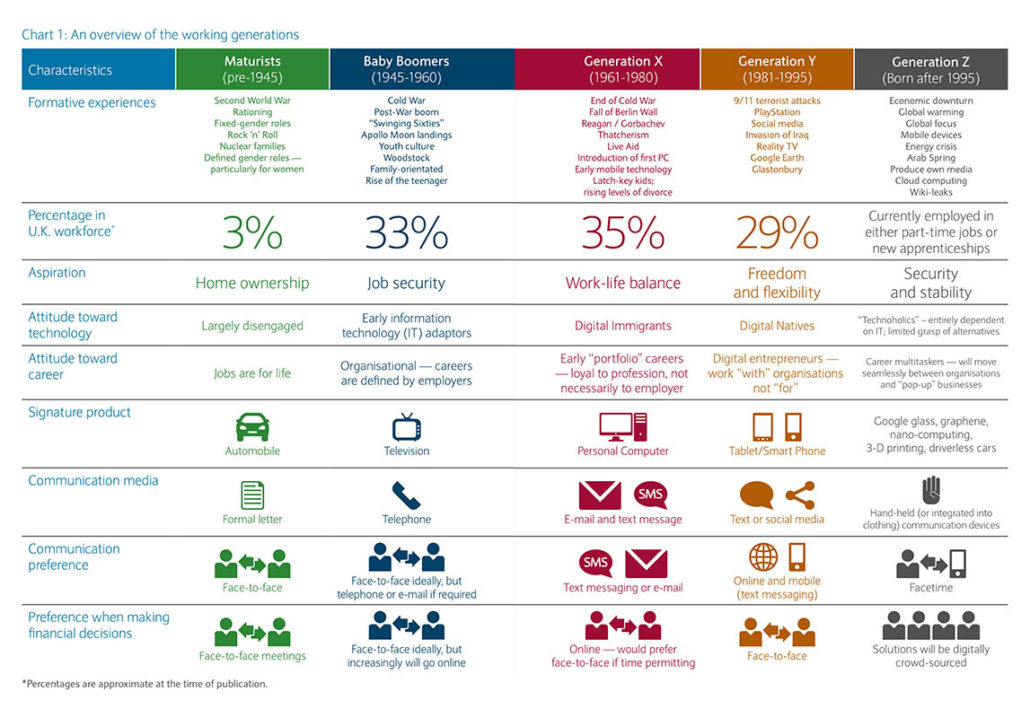Many employers aren’t aware that this is the first time in history that they’re likely to be confronted with up to five different generations of talent—all under one roof.
What exactly are the differences between each generation? How do they affect the workplace culture? What’s the best way to manage a multi-generational workforce?
To answer these questions, we need to start by defining each. As we examine each generation’s core values, we’ll discover how each has been influenced by a single common factor: technology.
Generations in the Workforce
The Silent Generation is the oldest of the generations. Born before 1945, they value discipline and stability. They are the farthest removed from technology and are least likely to engage with digital trends. The Silent Generation is hard-working—having been raised during the Great Depression—these individuals are loyal to their employers and usually have only one or two of them throughout their lifetime.
Baby Boomers—or ‘Boomers’—as they’re often referred to, are the next generation of workers, born roughly between 1946 and 1964. These are the early adopters of technology. With the invention of the television, this generation set the stage for the future of technological innovation. Boomers are work-centric and value job security. They hold many positions of power in the current workforce and are generally well-established in their careers.
Generation X is the generation born between 1965 and 1979. They were the first generation introduced to personal computers (PCs) and marked a pivotal point in communication preference. Most Gen Xers prefer digital forms of communication over telephone and letters. They value autonomy in the workplace and flexible work environments.
More recently, the term ‘Xennials’ has been coined to describe the generational cohorts born between 1975 and 1985. These individuals exhibit characteristics of both Gen X and the Millennial generation. Career Planner refers to them as the “crossover generation”, with “the idea being that Xennials are more like the preceding Gen X than they are like Millennials”.
Generation Y “Millennials” were born between 1980 and 1995. This generation grew up in a home where almost every house had access to a computer and an internet connection. Often referred to as “Digital Natives”, Millennials are very familiar with technology and prefer it over traditional forms of communication. In addition, Millennials are seeking a greater work-life balance. They want jobs that are rewarding in both their professional lives as well as their personal lives. Many Millennials will have several different employers throughout their lifetime.
Finally, Generation Z —the generation born after 1996 —has never known the world without technology, which has led them to become nearly dependent on it in their everyday lives.
How to Manage A Multi-Generational Workforce
Managing a diverse group of individuals isn’t always easy, but companies must understand how their workforce functions and why to maintain positive working relationships.
These four strategies will help nurture a multi-generational workforce.
1. Respect Core Values
The number one rule in fostering an inclusive work environment is to respect your employee’s core values. Younger generations value better work-life balance than older generations. You can support this as an employer by offering various benefits to suit your workforce’s diverse needs. Consider offering PTO in addition to sick leave if you don’t have this option, which isn’t already available.
2. Balance Communication Styles
Communication style preferences have shifted over the years. Traditionalists and Boomers prefer face-to-face interaction, while Gen Xers, Millennials, and Gen Z prefer less personal interaction, such as email, text messaging, and social media. To foster an inclusive workplace, you should implement a variety of each of these communication styles. Your older generational cohorts will appreciate the more personal interaction, and your younger generational cohorts will appreciate the opportunity to communicate quickly and efficiently.
3. Provide Support
There’s nothing more frustrating than wasting time trying to figure out how to use technology. Employers need to provide support options to their employees so that they can spend their time working instead of troubleshooting.
4. Encourage Employee Feedback
Finally, take the time to listen to your employees. Find out what is working and—more importantly—what isn’t. Take an active role in mitigating problems that do arise. Ask your employees for suggestions on improving the business; then use those suggestions. When you clarify to your workforce that you value their opinion, they’ll feel more confident in coming to you with their questions and concerns.
Generational diversity and tech are two sides of the same coin. While they are not mutually exclusive, we’ve discussed the various ways in which they influence each other.
Practicing these strategies will help you cultivate a generationally diverse workforce and strengthen your relationship with your employees.
(Image via: Barclays)
Are you ready for the future workforce?
Download the FREE Future of Work Report directly to your inbox. It houses valuable insights into the future of work and how your organization can be prepared for whats ahead.



